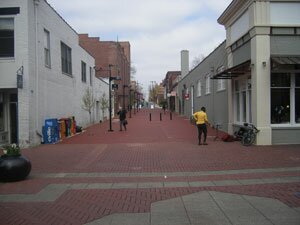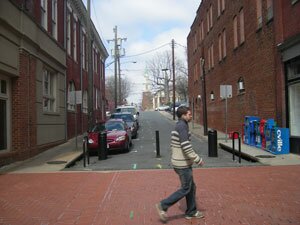ONARCHITECTURE- Downtown Mall: City works sideways on side streets

Third Street high: "I think it will be much better to have a business here," says salon owner T.T. Jackson. "We see a lot more people strolling through."
PHOTO BY DAVE MCNAIR
Now that the $800,000 Third Street project on the Downtown Mall is done, T.T. Jackson, who owns the Jackson II Beauty Salon, says that businesses along the beleaguered street are "finally seeing the light" at the end of their business nightmare. In fact, because the street looks so much better– with new brick, lighting, underground utilities, trees, and an overall layout that expands the pedestrian footprint of the Mall– Jackson thinks the long wait may have been worth it.
"I think it will be much better to have a business here," she says. "We see a lot more people strolling through."
Unfortunately, her neighbor Shirley Barrett, who ran a nail salon, was not as fortunate. Barrett, who told the Hook she had "grown tired" of the construction last November, appears to have closed up shop, and a bakery called Cappallino's Crazy Cakes has just signed a lease for the space (see Dish, page XX). Attempts to reach Barrett were unsuccessful. But the closure should come as no surprise. Four years ago, when the Paramount Theater was being renovated, Barrett told the Hook that her business was down 20 to 25 percent.
"Seniors have problems," she said, a refrain she repeated again last fall during the streetscaping project. "They fear the noise, and they're afraid of the overhead crane going over the building. And they can't drive up to the door."
Still, for folks like Jackson who seem to have survived the long construction process, the Third Street renovation offers new opportunities. Indeed, Crazy Cakes owner Frank Cappallino, who plans to open in May, says he couldn't be happier with the location and the new streetscape out front.
While city spokesperson Ric Barrick says there have been a few problems with vehicles mistaking Third Street for a crossing (sandwich board signs saying "pedestrians only" have been put up), he says larger permanent signage will be installed, and he promises no bollards. He also says that some restaurants on the street have already applied for outdoor seating space.
Indeed, the street has now become an extension of the Mall, inviting strolling just as the main thoroughfare does. In addition, people driving by Third Street on Market, can actually "see" and recognize the Mall, which is not the case at other side street entrances.
Former city councilor Kevin Lynch recalled during a planning session for the 4th Street crossing several months ago how he was standing in front of the Market Street Wine Shop when a tourist pulled up and asked him where the Mall was.
As the city gears up for a $7.5 million-renovation of the Mall, which will include new brickwork, drainage repair, tree work, new street-lighting, overhead and underground utility adjustments, and new furniture and signage, some people wonder why more attention isn't being paid to finishing the side streets, especially because so many side street projects are already in the works.
After all, the Market Street side of Third Street is done, the Water Street side of First Street is done, the renovation of the Second Street crossing is in the works, improved streetscaping on the Water Street side will be part of the new Landmark Hotel, and the Fourth Street crossing was made permanent by City Council on April 7.
As part of a $1 million renovation, Fourth Street from Water to Garrett Street will be made two-way. But the change will be reevaluated in a year to address concerns about cut-through traffic. That leaves just five side streets– the Market Street side of First Street, the Market Street side of Second Street SE, the Water Street side of Third, and Fifth Street.
Even at the Third Street price of $800,000– twice a much as originally projected– and a timetable that took twice as long, that's just $4 million to expand the pedestrian footprint of the Mall considerably, make it more visible to motorists, and allow businesses on the side streets to thrive.
Which might be a wise investment– downtown developer Oliver Kuttner told the Hook, "Businesses on the side streets are dying. If you want to spent $10 million, then start with Water Street and the side streets, where anything would be an improvement."
The 2005 Mall study done by Wallace, Roberts, and Todd– which is being used ad a guide for the Mall renovation– called for improving the side streets to extend the Mall's pedestrian orientation. A new design from MMM Design Group (under contract to do the Mall renovation) also included designs for the side streets. But the city has chosen not to focus on the side streets as part of the Mall renovation.
Architect Gary Okerlund, an advisor to the WRT report, told the Hook that could be a big mistake.
"Going piecemeal is very dangerous," he said. "You have to have a solid design concept; otherwise, you're going to lose all continuity. The WRT concept should be the backbone of this renovation."
"I agree that going piecemeal is dangerous," says city Planning Commissioner Mike Farruggio, "and my fear is that it won't get done in a timely manner." Farruggio likes the idea of getting the side streets done "because it gives the Mall more of an area to be what it is, to do what it does best–invite pedestrians downtown. Plus, doing the side streets would bring the Mall to Water and Market streets and make it much more visible."
"Of course, the side streets need to be done," says Board of Architectural Review vice-chair Syd Knight, "but I suspect the City is facing a case of having more needs and plans than money. If they can't do both the Mall and the side streets as they originally intended, which do they do? Both options have strong, logical arguments in their favor."
Indeed, Knight thinks the Mall is in as bad shape as the sidestreets, but he says logic dictates fixing the Mall first: "After all, what good would renovated side streets be if they only lead to an aging, crumbling Mall?"
"I love the idea of doing as many side streets as we can as quickly as we can," says Mayor Dave Norris. "Despite the problems that Third Street had, I think it looks great. However, with the economic downturn we're in, resources are a little tighter than we might like, which means we may not be able to devote the millions of extra dollars to doing the Mall and side streets all at once."
"If you ask yourself, 'What's the most important public space in Charlottesville, the heart of the City?the answer is obviously the Mall," says Knight. "I'd love to have it both ways, to have the Mall renovated and the side streets done, but I can understand that it may just not be possible. It's a tough, tough choice, and it certainly doesn't seem to have a magic solution."

First Street low: many downtowners decry the condition of Mall sidestreets, and city planners agree they need to be renovated. But will they ever get done?
PHOTO BY DAVE MCNAIR
#